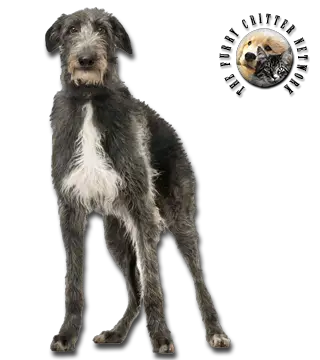Breed Standard
Head: Long. Skull fairly flat, covered with hair of medium length and softer than on the rest of the body. No stop. Muzzle tapering toward the nose. Tight-lipped. Strong jaws.
Ears: Set on high, small, folded back at rest. Black or dark in color.
Eyes: Dark, either dark brown or hazel. Edge of eyelids black.
Body: Like that of a Greyhound, but larger. Neck very strong, without dewlap. Chest taller than it is wide. Well-arched loin. Broad, powerful croup.
Hair: Shaggy, thick, close-lying, uneven, rough or crisp. Hard, wiry hair 7 to 10 cm long on the body, neck, and hindquarters. Much softer on the head, chest, and abdomen. Light feathering on the inner legs.
Coat: Dark blue-grey; darker and lighter shades of grey; brindle and yellow; sand or reddish-fawn with black extremities; white chest and toes and a small white spot on the tip of the tail are allowed.
Size: Dog: at least 76 cm. (30 in).Bitch: at least 71 cm. (28 in).
Weight: Dog: approx. 45.5 kg. (100.5 lb).Bitch: approx. 36.5 kg.
History
The Deerhound has long existed in Scotland, where he might have arrived with Phoenician merchants or Celtic invaders. The breed quickly became a favorite of clan leaders. He received his name because he was once used to hunt fallow deer. When fallow deer became scarce, Deerhound breeding was nearly abandoned. British breeders worked to preserve and improve the Deerhound, and the first standard was written in 1892.
Behavior
The Scottish Deerhound is gentle and extremely friendly. The breed is famed for being docile and eager to please, with a bearing of gentle dignity. It is however a true sighthound which has been selected for generations to pursue game; consequently, most Deerhounds will be eager to chase.
The Deerhound needs considerable exercise when young to develop properly and to maintain its health and condition. That does not mean it needs a large house to live in; however it should have regular access to free exercise in a fenced or otherwise "safe" area. Deerhounds should not be raised with access only to leash walking or a small yard, this would be detrimental to their health and development. City dwellers with conviction, however, can keep the dog both healthy and happy, as long as they are willing to take their Deerhounds to nearby parks for lengthy runs and rigorous fetching sessions within these wider running courses.
Young Deerhounds can sometimes, depending on the individual, be quite destructive especially when they are not given sufficient exercise; however, the average adult Deerhound may want to spend most of the day stretched out on the floor or a couch, sleeping. They do require a stimulus, preferably another Deerhound, and a large area to exercise properly and frequently. They are gentle and docile indoors and are generally good around company and children. However, due to their size, they require supervision with young children.
He is not suited to apartment life. He prefers to live outdoors, where he can get lots of exercise. He does not tolerate heat well, and he requires regular brushing.
Function
Companion Dog.
Health
The serious health issues in the breed include cardiomyopathy; osteosarcoma; bloat; stomach or splenic torsion, called Gastric dilatation volvulus; and cystinuria. See current health studies.
Like other sighthounds, deerhounds have unique anatomical and physiological features likely due to intentional selection for hunting by speed and sight. Laboratory studies have established reference intervals for haematology and serum biochemical profiles in Deerhounds, some of which are shared by all sighthounds, and some of which may be unique to this breed.






